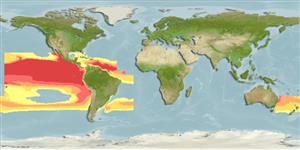>
Aulopiformes (Grinners) >
Scopelarchidae (Pearleyes)
Etymology: Scopelarchoides: Greek, skopelos = a lantern fish + Greek, archos = anus + Greek, oides = similar (Ref. 45335).
Environment: milieu / climate zone / depth range / distribution range
Ökologie
seewasser bathypelagisch; tiefenbereich 1 - 3294 m (Ref. 26340). Deep-water; 27°N -
Western Central Atlantic: Cuba (Ref. 26340). Eastern Pacific: Baja California, Mexico (about 27°N) to equatorial waters off Panama and Colombia (5°-9°N), and off Peru (about 6°-12°S) (Ref. 35929); also Chile (Ref. 9068).
Size / Gewicht / Alter
Maturity: Lm ? range ? - ? cm
Max length : 10.5 cm SL Männchen/unbestimmt; (Ref. 130965)
Rückenflossenstacheln (insgesamt) : 0; Rückenflossenweichstrahlen (insgesamt) : 6 - 7; Afterflossenstacheln: 0; Afterflossenweichstrahlen: 20 - 23; Wirbelzahl: 45 - 48. Branchiostegal rays: 8.
Occur in shallower part of depth range at night, deeper during the day (Ref. 35929). Oviparous, with planktonic larvae (Ref. 35929). Synchronous hermaphrodites (Ref. 35929).
Life cycle and mating behavior
Maturities | Fortpflanzung | Spawnings | Egg(s) | Fecundities | Larven
Claro, R., 1994. Características generales de la ictiofauna. p. 55-70. In R. Claro (ed.) Ecología de los peces marinos de Cuba. Instituto de Oceanología Academia de Ciencias de Cuba and Centro de Investigaciones de Quintana Roo. (Ref. 26340)
IUCN Rote Liste Status (Ref. 130435)
Bedrohung für Menschen
Harmless
Nutzung durch Menschen
Tools
Zusatzinformationen
Download XML
Internet Quellen
Estimates based on models
Preferred temperature (Ref.
123201): 3.5 - 9.5, mean 5.2 °C (based on 238 cells).
Phylogenetic diversity index (Ref.
82804): PD
50 = 0.5313 [Uniqueness, from 0.5 = low to 2.0 = high].
Bayesian length-weight: a=0.01122 (0.00514 - 0.02450), b=3.04 (2.87 - 3.21), in cm total length, based on all LWR estimates for this body shape (Ref.
93245).
Trophic level (Ref.
69278): 4.1 ±0.7 se; based on size and trophs of closest relatives
Fishing Vulnerability (Ref.
59153): Low vulnerability (10 of 100).
